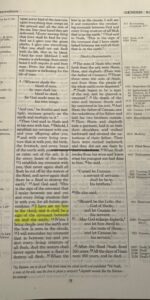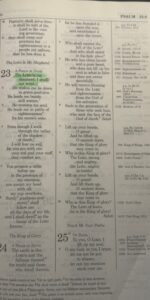Color Coding Bible Highlights: A Simple Guide to Engage Deeply With Scripture (+ Free Printables)
Please note that this article may contain affiliate links. As an Amazon Associate, I earn on qualifying purchases at no additional cost to you. You can read more at the bottom of this page or read my full disclosure on my Affiliate Disclosure Page
Have you ever opened your Bible, started reading, and found your mind wandering halfway through a verse? Maybe you’ve underlined passages here and there, but when you flip back later, it’s hard to remember why they mattered in the moment.
You’re not alone. Many of us struggle to stay engaged, especially when our study time starts to feel routine or rushed. We want to absorb more, understand more, and remember what God is saying—but the text can blur together, and those beautiful truths we read in the morning get lost by lunchtime.
That’s where color coding Bible highlights comes in.
This isn’t just about making your pages pretty. It’s a simple, powerful tool to help you stay focused, understand Scripture more clearly, and reflect deeply on what God is saying. With just a few intentional colors, you can bring structure and meaning to your quiet time—and begin seeing connections and patterns you may have missed before.
In this post, I’ll walk you through practical, easy-to-follow Bible highlighting methods, from beginner-friendly color systems to more advanced faith-based themes. Whether you’ve never picked up a highlighter or you’re looking to refine your current system, you’ll find everything you need to start strong—including a free printable color code chart to help you along the way.

Why Color Coding Your Bible is a Game-Changer
Benefits of Highlighting Scripture
A good Bible marking guide doesn’t just color up the page—it creates a visual path for reflection, prayer, and transformation. When you highlight with intention, your Bible becomes more than a book—it becomes a personal conversation with God.
How Color Coding Affects Retention and Meditation
The act of assigning meaning to specific colors taps into visual memory, helping you recall Scripture and apply it more effectively. Using a consistent Bible color coding system also makes it easier to meditate on themes like God’s promises, commands, and attributes in your daily walk.
Beginner’s Guide: How to Start Color Coding Your Bible
Step-by-Step Bible Highlighting Tutorial
- Choose your categories or themes
- Pick highlighters that are safe for thin Bible paper
- Create a quick-reference chart or bookmark
- Start in a single book (Psalms or John is great for beginners)
- Highlight only what stands out as meaningful or relevant to your study
The key is to stay flexible while still aiming for consistency.
What You’ll Need: Bible-Safe Highlighters & Tools
- Mr. Pen No-Bleed Gel Highlighters
- Zebrite Bible Highlighters
- Pilot Frixion (erasable for margin notes)
- A simple ruler and Bible-safe pens
Use highlighters specifically designed for Bible study to avoid damaging delicate pages.
Practical Tips for First-Time Highlighters
- Always test your colors on a back page
- Stick to 4–6 colors to start
- Keep a printed or taped-in scripture color coding chart nearby
- Use sticky tabs or a journaling notebook for extended reflections
Popular Color Coding Systems (With Printable Chart)
Simple 5-Color System for New Bible Readers
- Yellow – God’s promises
- Blue – Commands or instructions
- Green – Spiritual growth and wisdom
- Pink – Prayer and praise
- Orange – Warnings or sin
Comprehensive 10-Color Theme System (For Deeper Study)
- Purple – God’s attributes
- Red – Jesus’ words or salvation
- Light Blue – Holy Spirit
- Dark Green – Faith or trust
- Brown – Historical context or setting
- Gray – Sin, doubt, or temptation
- Black – Satan or evil forces
- Gold – Heaven and eternity
- Teal – Prophecy
- Magenta – Joy and worship
Free Color Code Bookmark PDF (Download Here)
Download Free Bible Highlighting Chart + Bookmark
Choosing Themes to Highlight in Your Bible
God’s Attributes
Use color to highlight where God shows His nature—His faithfulness, power, mercy, or righteousness. These verses help you grow in worship and trust.
Commands, Promises, and Prayers
- Promises: What God declares He will do
- Commands: What He instructs us to obey
- Prayers: Examples of how people in the Bible spoke to Him
Sins, Warnings, and Prophecies
Marking these verses helps us stay alert spiritually and remember the cost of sin and the hope of redemption. Prophetic verses often point to Jesus, which you can highlight with red or teal.
Examples: How to Use Each Color in Real Scripture Passages
Old Testament Sample
- Genesis 9:13 – Yellow: God’s promise to Noah
I have set My rainbow in the cloud, and it shall serve as a sign of a covenant between Me and the earth.

- Genesis 1:27 – Purple: God’s attributes as Creator
So God created man in His own image, in the image of God He created him; male and female He created them.
- Psalm 23:1 – Green: Spiritual growth or Yellow for Promise
The Lord is my shepherd,
I will not be in need.

New Testament Sample
- Matthew 5:14 – Jesus’ words are highlighted in red.
“You are the light of the world. A city set on a hill cannot be hidden;”
- John 14:6 – Red for Jesus’ words. Possibly gold if you’re focusing on eternal life.
Jesus *said to him, “I am the way, and the truth, and the life; no one comes to the Father except through Me.
- Ephesians 2:8 – Pink: Grace or salvation
For by grace you have been saved through faith; and this is not of yourselves, it is the gift of God;

Creative Add-ons: Symbols, Stickers & Journaling Combos
How to Add Simple Icons Beside Highlights
- Hearts: Love
- Stars: Important truths
- Arrows: Application points
- Exclamation points: Key doctrines
Using Stickers & Washi Tape in the Margins
These add personality and visual cues. Use washi tape to mark a theme by book, or place a sticker as a visual prayer reminder. Great for creative and visual learners!
Common Mistakes to Avoid When Highlighting Your Bible
What NOT to Highlight
- Avoid over-highlighting
- Don’t highlight without understanding the context
- Don’t switch color meanings mid-way unless updated in your key chart
How to Fix Mistakes Without Ruining Your Bible
- Use erasable highlighters or pens
- Cover errors with correction tape
- Layer stickers or symbols over mistakes
- Use transparent sticky notes
Best Highlighters and Pens for Bible Pages
- Mr. Pen Gel Highlighters
- ZEYAR Gel Highlighters
- G.T. Luscombe Bible Highlighters
- BLIEVE Bible Highlighters
Printable Tools & Resources to Get Started
Color Coding Ideas by Bible Study Method
Inductive Bible Study Color Code
The inductive method is all about slowing down and letting Scripture speak for itself. It focuses on three steps: Observation, Interpretation, and Application. Color coding helps you visually separate those layers as you read and study.
Observation: What does the text say?
In this step, you’re identifying key facts—names, places, repeated words, comparisons, contrasts, and time references. These are the “what,” “who,” “when,” and “where” of the passage.
Suggested color: Blue
- Key people and places
- Repeated words or phrases
- Significant actions
- Time indicators (e.g., “on the third day,” “afterward”)
Interpretation: What does the text mean?
Now you’re asking why the details matter. What is the main message? What is the author trying to communicate? Are there any cultural or theological insights?
Suggested color: Green
- Cause and effect statements
- Definitions or explanations
- Key theological concepts or doctrines
- Comparisons or contrasts (e.g., “but,” “therefore”)
Application: How does the text apply to my life?
This is where Scripture gets personal. What truth do you need to believe? What action is God calling you to take? What promises do you need to cling to?
Suggested color: Purple
- Direct commands or calls to obedience
- Promises to claim
- Personal challenges or conviction
- Encouraging truths to meditate on
Optional: Write margin notes or journal responses in a matching pen color to deepen the practice. This method works especially well if you’re doing verse-by-verse studies or working through a whole book of the Bible.
Topical Bible Study Color Code
If you enjoy focusing on a theme or spiritual topic—like faith, grace, forgiveness, or spiritual warfare—topical color coding is a great way to trace that theme throughout Scripture.
This method helps you connect the dots between verses, books, and even Testaments. By assigning each topic a color, you’ll start to see patterns and deeper meaning emerge in God’s Word.
Here are some color ideas and Scripture examples to get you started:
- Faith – Blue: Highlight verses that speak about trusting God, belief, and walking by faith. Example: Hebrews 11:1
- Grace – Pink: Use pink to highlight God’s undeserved favor, forgiveness, and salvation. Example: Ephesians 2:8
- Obedience – Orange: Mark verses that deal with listening to God or being doers of the Word. Example: James 1:22
- Prayer – Purple: Use purple for conversations with God or teachings on prayer. Example: Philippians 4:6
- Spiritual Warfare – Red: Highlight spiritual battles or the armor of God. Example: Ephesians 6:11
- Wisdom – Green: Use green for godly counsel or instruction. Example: Proverbs 9:10
You can choose as many or as few topics as you like. Some people start with 3–5 core themes that reflect what they’re currently studying, then expand over time.
To stay consistent, create a color code card or bookmark and keep it tucked inside your Bible. That way, you’ll always remember what each color means.
How to Teach Kids and Teens to Color Code Their Bibles
- Choose 3–4 simple categories (like God, sin, prayer, promise)
- Use bright, distinct colors
- Create a fun printable key with icons or stickers
- Let them add a personal symbol (like a smiley face for joy!)
This can be a great way to disciple your kids and make the Bible more approachable for them.
My Final Thoughts
Bible study doesn’t have to feel overwhelming or flat. When you approach God’s Word with intention—and a system that helps you slow down and focus—you create space for real connection, not just comprehension. Color coding Bible highlights is one of the most practical, visual ways to do that. It turns your Bible into a living journal of your faith walk.
And the beautiful part? It’s fully personal. No two color-coded Bibles look the same, because God speaks to each of us in unique, powerful ways. Your Bible becomes a reflection of your relationship with Him—what He’s teaching you, the promises you’re holding onto, and the commands you’re learning to follow with courage.
You don’t have to be artistic. You don’t need all the fancy tools. You just need a willing heart and a little bit of margin in your day to sit, highlight, and listen.
I’d love to know—have you tried color coding your Bible before? What’s worked for you? What’s been challenging?
FAQs for Color Coding Bible Highlights
-
How is Bible color coding different from just highlighting favorite verses?
Color coding assigns meaning to each color—such as promises, commands, or prayers—so you study with intention and remember Scripture more clearly.
-
Can I use regular highlighters in my Bible?
Regular highlighters often bleed through Bible pages. Use gel or Bible-safe highlighters made specifically for thin paper to protect your Bible.
-
What should I do if I change my mind about my color system?
You can revise your system anytime. Cover old highlights with correction tape, washi tape, or make notes to clarify changes in your color key.
-
Is it okay to write notes or draw in my Bible?
Yes! Writing prayers, reflections, or drawings helps personalize your study and deepen your relationship with God. There’s no wrong way to respond.
-
Can I change my Bible color code over time?
Absolutely. As your study habits and focus change, feel free to update your system. Just revise your key and stay consistent going forward.
-
Can kids and teens use a Bible color coding system?
Definitely. Use fewer colors, fun symbols, and engaging visuals to help kids and teens learn how to interact meaningfully with Scripture.
-
What if I make a mistake while highlighting?
Mistakes are normal. Try correction tape, stickers, or margin notes to fix or clarify. Bible study is about growth, not perfection.
-
Do I need a printable chart or can I just remember my colors?
While some people memorize their color system, having a printed key or bookmark helps you stay consistent—especially when just starting out.

Sue Nelson is a Christian author, Bible teacher, and conference speaker with a heart for helping women grow deeper in their walk with God. She has written several books on Christian marriage, Proverbs 31 living, verse mapping, and the Twelve Tribes of Israel. Her Bible studies and devotional tools are used by women’s ministries across the United States.
With years of experience teaching Scripture and leading small groups, Sue has spoken at numerous women’s conferences and retreats nationwide. She actively serves in multiple ministries at her home church—including Hospitality, Welcome PSG Corp, and Leaders of the Pack—and is known for her willingness to serve wherever there’s a need.
A wife, mom, grandmother, and proud dog/cat mom, Sue lives a life centered on Christ. She supports a wide range of Christian causes, including Bible distribution, scholarships for faith-based retreats, homeless outreach, food pantries, and clothing ministries.
You can connect with her through her women’s Bible study community, She Opens Her Bible
NASB – “Scripture quotations taken from the NASB. Copyright by The Lockman Foundation“
